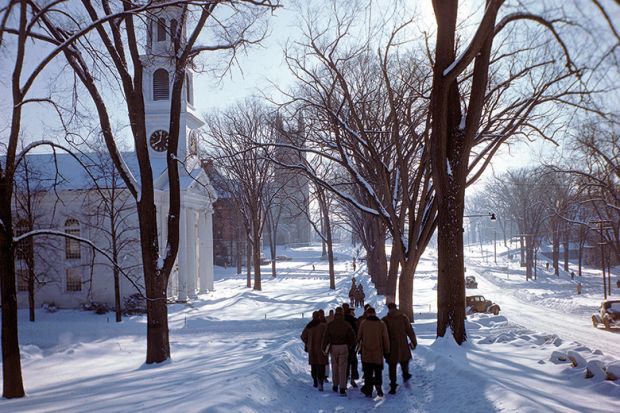View the full results of the Wall Street Journal/Times Higher Education College Rankings 2018
"The level of academic integrity is superb. [It is] constantly challenging and forcing you to think outside of the box.”
“The professors really care about teaching me to think critically.”
“It would be refreshing and a great improvement…if the school further encouraged difference of ideological thought.”
“We talk a big talk about diversity and inclusion, but are extremely white and upper-middle class as a student body.”
These words from students at liberal arts colleges in Massachusetts, California and Minnesota sum up the perceived characteristics of education at such small, private institutions in the US. While they are widely hailed as higher education’s leading lights when it comes to student engagement, they are also generally considered a model that exclusively serves the elite.
The results of our 2018 ranking of US universities and colleges, in partnership with The Wall Street Journal, suggests that the experiences of these students, who were among the 200,000 to participate in the Times Higher Education US Student Survey in 2016 and 2017, match reality (see graph, below).
Vital statistics: how do liberal arts colleges compare with other institutions?
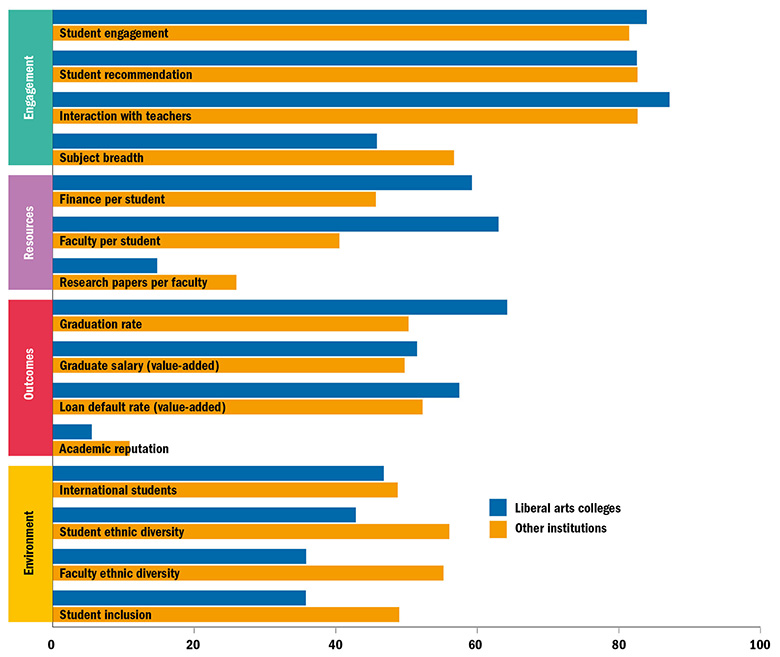
Note: Overall academic reputation scores are low because the score is based on recommendations from scholars, which tend to focus on a small number of very highly regarded institutions
Liberal arts colleges make up about a third of institutions in the WSJ/THE US College Rankings, the latest iteration of which were published on 28 September. They achieve an average score of just 35.8 out of 100 on a measure of their inclusion of students from poorer backgrounds, compared with 49.0 for other institutions.
Liberal arts colleges also fall well behind other higher education institutions when it comes to the ethnic diversity of students and faculty; their average scores on these metrics are 42.8 and 35.8 out of 100 respectively, compared with 56.0 and 55.2 for other institutions.
But when it comes to indicators of student engagement, which are based on the views of students who participated in the survey, liberal arts institutions are ahead of the competition – and improving. The colleges achieved an average score of 87.2 for student interaction with faculty and peers (compared with 82.6 for other universities). They also score 83.9 for engagement (compared with 81.4 for others): a metric that assesses the extent to which the institution challenges students, supports critical thinking and helps students to reflect on their learning and apply it to the real world (see methodology).
Part of this is down to money. Liberal arts colleges as a body are much richer than other institutions. On average, academic spending per student per year at a liberal arts institution is $18,300 (£13,500), compared with $15,700 at other institutions. Meanwhile, the student-to-staff ratio at liberal arts colleges is 12:1 on average, compared with 16:1 elsewhere.
But while wealth is positively correlated with a strong faculty-to-student ratio and high graduation rates, it also may be part of the reason why liberal arts colleges have such homogeneous communities; institutions with the highest ranking positions and the most money tend to be worst at recruiting students from poor backgrounds (see scattergraphs, below).
Balancing act: how inclusion correlates with other metrics
Inclusion v total score
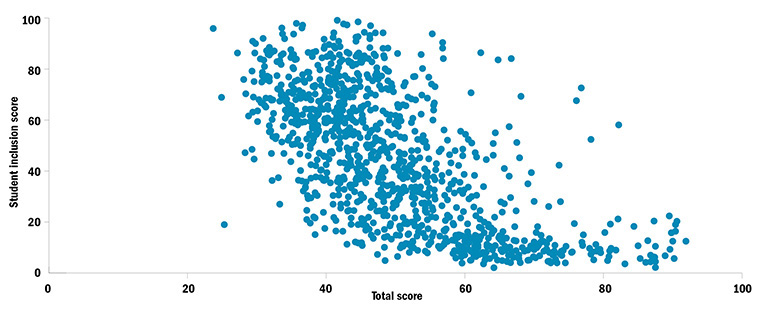
Inclusion v finance per student
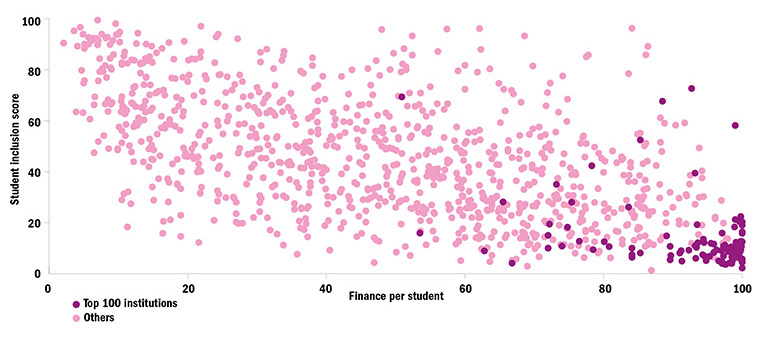
One reason is likely to be that while many elite institutions have generous financial aid programmes, the high sticker price of tuition at such colleges is a deterrent for students from lower socio-economic backgrounds. Another reason is top liberal arts colleges’ reputation for elitism.
And while US higher education institutions have improved when it comes to their intake of international students and the racial diversity of students on campus, their performance on recruitment of students from poorer backgrounds is worse than it was in last year’s ranking. Comments from students in the survey suggest that even colleges making progress in this area are struggling when it comes to integrating such students on campus.
For example, one respondent said that their college “need[s] to hire more tenure track faculty of colour and listen to the needs of students of colour, rather than just using them for their website and posters”. Another said that their college could improve by “making minority students feel welcome through more than just lip service”.
Top 20: Liberal arts colleges
|
Rank |
Overall 2018 rank |
Overall 2017 rank |
Institution |
State |
|
1 |
22 |
=23 |
Massachusetts |
|
|
2 |
23 |
=23 |
Massachusetts |
|
|
3 |
26 |
32 |
California |
|
|
4 |
28 |
29 |
Massachusetts |
|
|
5 |
30 |
=33 |
Pennsylvania |
|
|
6 |
35 |
49 |
California |
|
|
7 |
36 |
42 |
Vermont |
|
|
8 |
37 |
=33 |
Massachusetts |
|
|
9 |
38 |
=39 |
Minnesota |
|
|
10 |
39 |
46 |
Maine |
|
|
11 |
42 |
=35 |
Pennsylvania |
|
|
12 |
45 |
47 |
Connecticut |
|
|
13 |
49 |
=39 |
Pennsylvania |
|
|
14 |
54 |
65 |
North Carolina |
|
|
15 |
55 |
=58 |
New York |
|
|
16 |
59 |
51 |
Pennsylvania |
|
|
17 |
=61 |
64 |
New York |
|
|
18 |
63 |
=66 |
Ohio |
|
|
19 |
65 |
=66 |
Maine |
|
|
20 |
66 |
77 |
Maine |
View the top 100 liberal arts colleges in the US
Research shows that liberal arts colleges are also quite politically homogeneous. A 2012 study found that liberal arts students begin college with more liberal political views than their counterparts at other four-year institutions, but also become more liberal during their time in higher education.
Jana Hanson, director of institutional assessment at South Dakota State University and co-author of the study, says that she would expect similar results to be generated if the research were repeated today.
“We have selection bias issues – certain students may gravitate to certain types of institutions,” she says. “Higher education institutions have a responsibility to ensure students develop skills to engage in constructive dialogue with others who have different perspectives – no matter [their] political ideology.”
Liberal arts colleges’ lack of political diversity has not gone unnoticed by students. Asked how their institution could improve, one student responding to the THE survey wrote of their college in Massachusetts: “Because the majority of this campus has similar political views on social justice topics, people feel comfortable shutting down anyone who strays from the norm. Students at [this college] need to learn to listen to each other and have respectful and productive conversations.”
But some liberal arts colleges buck the trend and are strong performers when it comes to diversity in general. Mount Holyoke College, an institution for women in Massachusetts that ranks 77th overall, is joint first for its proportion of international students. According to Eva Paus, professor of economics and director of the McCulloch Center for Global Initiatives at the institution, the first international students arrived at the institution within two years of its foundation in 1837. Today, they make up 27 per cent of its total student body, following the introduction of internationalisation as a strategic priority about 14 years ago.
As well as encouraging US students to spend time abroad and offering international internship programmes, the college also hosts a biennial conference on solving global challenges and recruits global scholars-in-residence to give lectures, classes and informal gatherings on important global issues. As a result, Mount Holyoke also has a “very international faculty”, Paus says: “We conducted a survey in the spring and found that 31 per cent [of faculty] have lived outside the US for more than five years and 68 per cent speak a language other than English.”
In addition, 28 per cent of the college’s domestic student body is non-white, Paus adds.
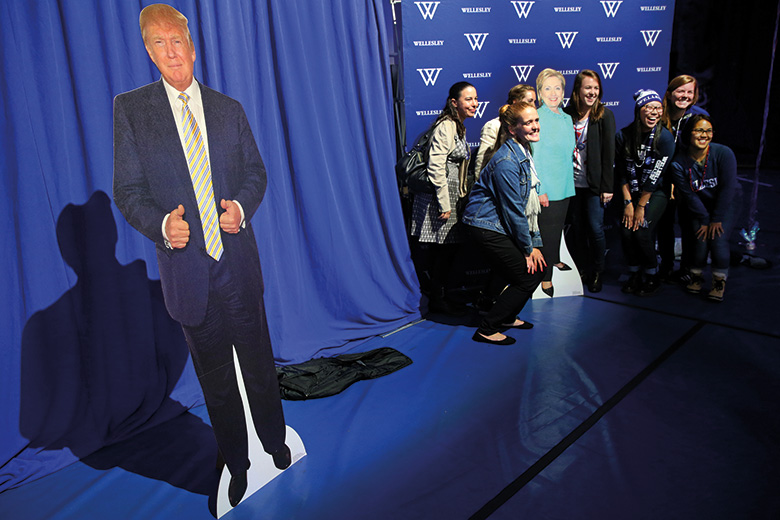
Alverno College in Wisconsin, another women’s institution, also rates highly for diversity. While the Catholic college is in the 501-600 band overall, it ranks 12th on the student inclusion metric, which measures how many students are recipients of Pell Grants (paid to students in need of financial support) and how many are among the first generation in their family to go to college.
Alverno also ranks highly for student interaction with faculty and peers, and for student engagement. Kate Lundeen, the institution’s vice president for enrolment services, says that the college has “always been dedicated to ensuring that a college degree is available and accessible to those who might otherwise have been excluded from higher education. Historically, that was women of all backgrounds, and today that often means students with fewer financial resources or connections to college,” she says.
Lundeen says that Alverno has been offering degrees in non-traditional formats for more than 40 years, making them accessible to working women. “Today our students share their concerns [with us] about the high cost of college and wanting each course to be relevant to their future careers and leadership opportunities,” she continues. “We respond [by] keeping our tuition among the lowest for private colleges in our region, and ensuring that the learning and engagement that happens in the classroom is always connected to abilities and skills that students will need after graduation.”
In practice, this means that students do not write essays or assignments “with the professor as their only audience”, but, instead, draft business plans, op-ed articles, care plans for their future patients and lesson plans for their future students.
While few institutions have been as successful as Alverno at recruiting students from across the socio-economic spectrum, many liberal arts colleges have made similar changes to their curriculum to prove their relevance to careers and, thereby, to attract a wider pool of applicants.
Top 20: Resources
|
Resources rank |
Overall 2018 rank |
Institution name |
Resources score |
|
1 |
7 |
30.0 |
|
|
2 |
1 |
29.8 |
|
|
3 |
=3 |
29.2 |
|
|
4 |
9 |
28.1 |
|
|
=5 |
=15 |
27.2 |
|
|
=5 |
14 |
27.2 |
|
|
=7 |
2 |
27.0 |
|
|
=7 |
8 |
27.0 |
|
|
9 |
=11 |
University of Chicago |
26.9 |
|
=10 |
=11 |
26.8 |
|
|
=10 |
10 |
26.8 |
|
|
=10 |
6 |
26.8 |
|
|
13 |
5 |
26.7 |
|
|
14 |
=17 |
26.6 |
|
|
=15 |
=3 |
26.2 |
|
|
=15 |
=11 |
26.2 |
|
|
17 |
19 |
26.0 |
|
|
18 |
32 |
25.8 |
|
|
19 |
=17 |
25.7 |
|
|
20 |
21 |
25.5 |
A paper published in Liberal Education in 2012 found that the education offer at liberal arts colleges was changing dramatically. “Although many one-time liberal arts colleges cling to that historical identity in their mission statements and promotional literature, our findings confirm a continuing drift away from the traditional arts and sciences-based model of a liberal arts college education,” it says.
The study was a response to a 1990 article called “Are We Losing Our Liberal Arts Colleges?” by educator and economist David Breneman, who claimed that just 212 institutions met his criteria for defining liberal arts colleges: institutions with a majority of undergraduates majoring in traditional arts and sciences fields, and without substantial graduate programmes. By 2012, the study found, that number had fallen to 130.
Vicki L. Baker, professor of economics and management at Albion College, Michigan, and co-author of the 2012 study, says that many of these colleges no longer met Breneman’s criteria because they began offering “graduate programmes, continuing education programmes or pre-professional education”. However, she sees this change as not so much a threat to the liberal arts model as a “rethinking [of] the way a liberal arts college education is defined in the 21st century…The approach to how these programmes are delivered is still very different…from what you would see at a larger research institution.”
The liberal arts approach often involves a greater focus on social responsibility and civic engagement, Baker says; she teaches business students how to be profitable while also contributing to the local community, for instance.
There are fears, however, that some of the changes being made by liberal arts institutions are destroying their USP and leading to deteriorating student outcomes. Chief among these are open curricula with no core requirements, allowing students to choose what to study regardless of their major.
Amherst College, the second highest liberal arts institution in the ranking at 23rd place, launched an open curriculum in 1971. Catherine Epstein, its dean of faculty, says that this is one reason why the intellectual engagement and graduation rates of its students are so high.
“Many of our classes are small, discussion-based and use active learning techniques. [Because] our students study what they want to study, with advice and guidance from their faculty advisers, they are interested in the courses they choose, and they participate,” she says.

Responses to THE’s survey also suggest that open curricula are welcomed by students. One Amherst student wrote: “Because we only get 32 classes, having [curricular] requirements would really limit the number of classes we can take that we genuinely want to take. The open curriculum allows us to pursue our interests.”
The student admits that this presents the danger that students only take classes “in one or two departments or fields, but Amherst does a great job of encouraging us to reach outside our comfort zones and challenge ourselves with what we take.”
However, not everyone is convinced. Michael Poliakoff is president of the American Council of Trustees and Alumni, a non-profit organisation that aims to support liberal arts education, uphold high academic standards and safeguard academic freedom. He says that many of the options offered by open curricula are centred on contemporary television series or popular culture, such as Harry Potter.
“It was once a reasonable expectation that a graduate of a liberal arts college would be somebody who had an intense background in careful writing, close reading, a comprehensive basis of foundational skills in natural sciences and mathematics – in other words, a person who had [followed] a real liberal arts curriculum,” he says. “But what we’re finding, especially among some of the most elite and expensive liberal arts colleges, is that they don’t deliver that.”
Last year, the council conducted a survey of 1,100 US institutions with a stated liberal arts mission, encompassing both private and public institutions. It found that only small proportions required students to take programmes in literature (35 per cent), US government or history (18 per cent), a foreign language (13 per cent) or economics (3 per cent).
Top 20: Engagement
|
Engagement rank |
Overall 2018 rank |
Institution name |
Engagement score |
|
1 |
=393 |
Dordt College |
18.2 |
|
2 |
=179 |
18.1 |
|
|
=3 |
=113 |
Brigham Young University–Provo |
17.9 |
|
=3 |
=367 |
17.9 |
|
|
=3 |
=93 |
17.9 |
|
|
=6 |
=188 |
17.7 |
|
|
=6 |
=11 |
17.7 |
|
|
=8 |
=306 |
17.6 |
|
|
=8 |
=164 |
17.6 |
|
|
=8 |
601-800 |
17.6 |
|
|
=8 |
=228 |
17.6 |
|
|
=8 |
=268 |
17.6 |
|
|
=8 |
501-600 |
17.6 |
|
|
=8 |
601-800 |
17.6 |
|
|
=8 |
=15 |
17.6 |
|
|
=8 |
=11 |
17.6 |
|
|
=17 |
10 |
17.5 |
|
|
=17 |
801+ |
17.5 |
|
|
=17 |
=371 |
Messiah College |
17.5 |
|
=17 |
=312 |
17.5 |
|
|
=17 |
=143 |
17.5 |
|
|
=17 |
=284 |
17.5 |
|
|
=17 |
=312 |
17.5 |
Poliakoff believes that this revision of curricula is largely down to “a rather myopic and misguided race to attract more students by offering a very broad cafeteria line of options, rather than actually…determining what it is that constitutes a well-educated graduate”. Moreover, the change in direction “comes at a very dangerous time” for liberal arts colleges, “when the public is intensely worried about the return on investment”.
Doubts about the financial value of a liberal arts degree were even picked up on by Donald Trump, during his run for president. His campaign policy director, Sam Clovis, proposed to make it harder for those wanting to major in the liberal arts to obtain a student loan.
“If you are going to study 16th-century French art, more power to you. I support the arts,” Clovis said. “But you are not going to get a job.”
Poliakoff says there are already signs that student outcomes at liberal arts colleges are deteriorating. He cites the 2011 book Academically Adrift , which revealed that 36 per cent of students who entered a four-year institution did not demonstrate any significant improvement in learning over the course of their degree – although the study was not limited to liberal arts institutions.
Liberal arts colleges are also very inefficient financially, which means that they are “unnecessarily expensive”, according to Poliakoff. A recent report by the council examining administrative costs at 1,200 four-year universities found that small baccalaureate colleges (the majority of which are liberal arts institutions) have the highest administrative costs. More than half of such colleges spend 50 cents or more on administration for every dollar spent on instruction.
“Interestingly enough, the Oxford colleges are famous for holding back on administrative expenditure,” says Poliakoff. “It’s really [a system] that focuses its resources into actual instruction. Maybe there is a lesson for our liberal arts colleges in recalibrating the…way they use their resources.”
According to Victor E. Ferrall, president emeritus of Beloit College, Wisconsin, and author of the 2011 book Liberal Arts at The Brink , the evolution of liberal arts colleges has a long history, beginning with the huge expansion in student numbers after the Second World War – including large numbers of government-funded war veterans.
“One of the aspects of [liberal arts] education that educators didn’t like to talk about was [the fact that] what you were studying was something that wasn’t practical. That led you to focus not so much on what you were learning but the act of learning itself, the act of thinking,” he says.
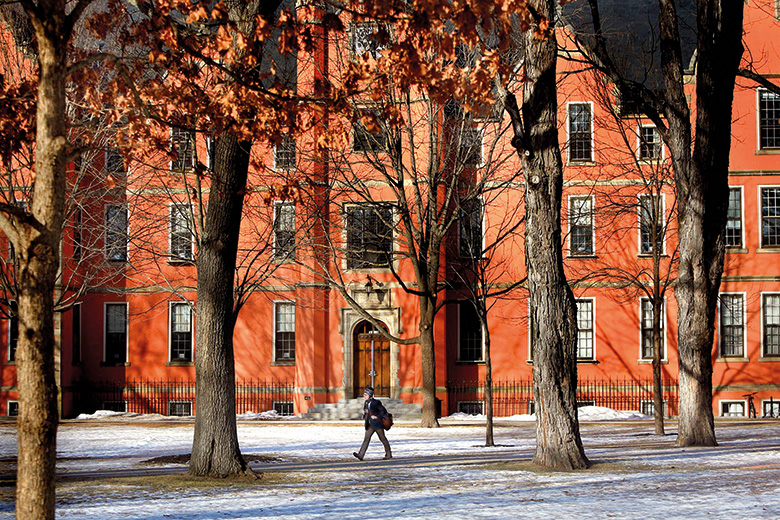
Faith in this system began to dwindle substantially in the early 1960s, he says, when “people became focused on what was the use of the education”. First-generation students, in particular, wanted to know whether a degree would secure them a job. The general public now “don’t understand” and don’t care about the value of liberal arts education, Ferrall says. “That new emphasis, plus the steadily rising cost of [studying], put a lot of pressure on colleges to deliver something that students wanted,” he says.
That is particularly true given the concentration of the liberal arts sector’s wealth in a handful of institutions, Ferrall adds. Some small institutions have either recently closed or are in danger of closing over financial difficulties. Financial troubles are also one major reason he does not believe that liberal arts colleges will take up the suggestion in his book to band together to promote their mission.
A survey of more than 400 prospective students by the Art & Science Group, a higher education consulting firm in Baltimore, found that the “liberal arts” label was enough to put off students from applying. The study , published in September, found that students associated liberal arts colleges with many characteristics of which the institutions themselves are proud, such as their high level of student-professor interaction and their focus on teaching critical thinking skills. The majority of respondents also agreed that a liberal arts education would make them a “well-rounded person”. But, when asked to rate the appeal of two hypothetical institutions, the students had a significant preference for the one that did not explicitly use the term “liberal arts” in its marketing material – even though it was otherwise identical to the control institution.
“Surprisingly, even students whose first-choice school was a liberal arts institution did not rate it higher on appeal when described as a ‘liberal arts’ institution,” adds Craig Goebel, principal at Art & Science Group. Goebel believes that the reasons include media reports of liberal arts institutions in “financial distress, graduates burdened with unfathomable debt, and challenges for graduates getting good jobs”, as well as politicians and other influential figures publicly questioning the value of a liberal arts degree.
There is little that colleges can do to counter such a cultural narrative, Goebel believes. So rather than trying to defend the concept of liberal arts education per se, he says that a better tactic would be for liberal arts institutions to “focus on their own distinctions and outcomes – the substance of the experience they offer students that sets them apart from their competitors”. This will allow them to “remain true to their mission, while also attracting the students and revenues needed to fulfil that mission”.
One college that has adopted such a strategy is Furman University in South Carolina, ranked joint 130th. Instead of simply referring to itself as a liberal arts college in its marketing material, the institution now explains “more clearly the skills and the connections and the opportunities our students have”, says its president, Elizabeth Davis.
“Just the word ‘liberal’ now makes people think we’re doing some very partisan things on campus, which would not be correct,” she says.
Top 20: Outcomes
|
Outcome rank |
Overall 2018 rank |
Institution name |
Outcomes score |
|
=1 |
5 |
39.5 |
|
|
=1 |
1 |
39.5 |
|
|
3 |
6 |
39.3 |
|
|
4 |
9 |
39.1 |
|
|
5 |
2 |
39.0 |
|
|
6 |
=3 |
38.9 |
|
|
7 |
7 |
38.8 |
|
|
8 |
8 |
38.4 |
|
|
=9 |
=11 |
University of Chicago |
38.2 |
|
=9 |
=3 |
38.2 |
|
|
=9 |
22 |
38.2 |
|
|
12 |
10 |
38.1 |
|
|
13 |
=17 |
37.7 |
|
|
=14 |
27 |
37.6 |
|
|
=14 |
33 |
37.6 |
|
|
=14 |
=11 |
37.6 |
|
|
17 |
23 |
37.5 |
|
|
18 |
21 |
37.4 |
|
|
=19 |
=17 |
37.0 |
|
|
=19 |
24 |
37.0 |
Enquiries about whether the institution teaches the sciences have also convinced it to refer to itself as a liberal arts and sciences university. However, Davis admits that it is hard to completely “lose” the “liberal arts college” label, not least because faculty and alumni have strong feelings about the concept of liberal arts education.
Besides, the problems that liberal arts colleges face extend well beyond perceptions, she says.
“When we make out as if [we] only [have] a marketing problem, the liberal arts colleges are just kicking the can down the road,” she says. “It’s really [about] creating a value proposition and leading with value. But there has to be something that’s valuable to lead with.”
Accordingly, Davis launched a new strategic vision last year called “The Furman Advantage”. This guarantees that every incoming student will receive opportunities for engaged learning experiences outside the classroom that are tracked and integrated with their academic and professional goals. Such experiences can include study abroad programmes, working with the local community and working with industry.
“A lot of our students were getting these kinds of experiences anyway but not every student was. So now we’ve created a system where we can track every student, where they can be advised and mentored to be sure that not only do they have the experiences but they know how to talk about them in a way so employers or graduate schools can understand the skills they’ve developed,” she says.
She adds that she is “optimistic” about the future of liberal arts colleges in the US, but she admits that such institutions “haven’t done a good job demonstrating the results that our students have because they’ve had this liberal arts education”.
To address this, Furman is in the process of building a “robust assessment mechanism” that will survey students and alumni at various points during their time at the college and throughout their subsequent careers. Davis believes this will demonstrate that Furman students go on to have higher levels of well-being and to be more engaged employees.
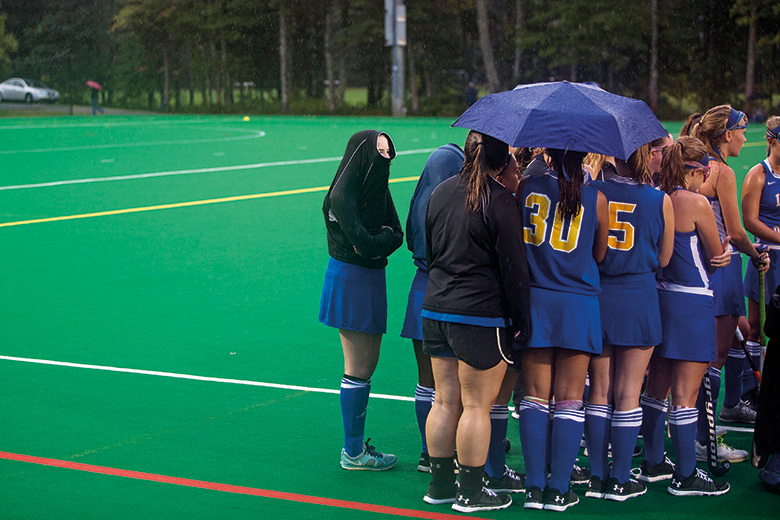
For his part, Poliakoff agrees that using metrics is a vital strategy for liberal arts institutions to prove their worth. But he adds that there is a “real suspicion”, across higher education, of “any kind of standardised approach to effectiveness”.
“Many of these institutions seem to have set themselves against using the kind of assessment metrics that would let them make their case that they really do advance the cognitive gain of their students,” he says.
On this, the WSJ/THE US College Rankings suggest that liberal arts colleges have much to shout about. The methodology includes two “value added” metrics – measuring the value added by the teaching to both salary and to graduates’ ability to repay student debt. Liberal arts colleges achieve a score of 51.5 and 57.5 on these indicators respectively, compared with 49.7 and 52.3 for other institutions.
Given the heated debate around the value of higher education in a high-cost era, such statistics could serve the liberal arts sector well. But not everyone is hopeful. For Beloit’s Ferrall, the future of liberal arts colleges is “bleak”.
“But no one seems to be very worried about it,” he adds. “And if no one is worried I don’t see how the [downward] trend is going to reverse.”
Top 20: Environment
|
Environment rank |
Overall 2018 rank |
Institution name |
Environment score |
|
1 |
601-800 |
9.3 |
|
|
2 |
601-800 |
9.2 |
|
|
=3 |
139 |
9.1 |
|
|
=3 |
801+ |
9.1 |
|
|
5 |
601-800 |
9.0 |
|
|
=6 |
501-600 |
8.9 |
|
|
=6 |
601-800 |
8.9 |
|
|
=8 |
271 |
8.8 |
|
|
=8 |
=272 |
8.8 |
|
|
=8 |
25 |
8.8 |
|
|
=8 |
=473 |
8.8 |
|
|
12 |
47 |
8.7 |
|
|
=13 |
501-600 |
8.6 |
|
|
=13 |
801+ |
8.6 |
|
|
=13 |
=460 |
8.6 |
|
|
=13 |
601-800 |
Nyack College |
8.6 |
|
=17 |
801+ |
8.5 |
|
|
=17 |
601-800 |
8.5 |
|
|
=17 |
=272 |
8.5 |
|
|
=17 |
=500 |
8.5 |
|
|
=17 |
601-800 |
8.5 |
|
|
=17 |
501-600 |
8.5 |
|
|
=17 |
=489 |
8.5 |
|
|
=17 |
601-800 |
8.5 |
|
|
=17 |
501-600 |
8.5 |
|
|
=17 |
601-800 |
8.5 |
|
|
=17 |
501-600 |
8.5 |
